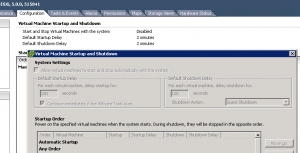 Reading Time: 3 minutes
Reading Time: 3 minutesHas written in the previous post, Dell EqualLogic Host Integration Tools for Linux 1.1 officially support only a few Linux OS, but it can work fine also on others. Actually the distributions is RPM based, so there is a bigger effor to port it to other distro, like Debian and Ubuntu.
I’ve tried with a updated release of CentOS 6.2 and it works fine, but you will need some packages that may be not installed (and also dkms that is not included in the installation source):
yum install iscsi-initiator-utils libpcap gcc make
rpm -Uhv http://packages.sw.be/rpmforge-release/rpmforge-release-0.5.2-2.el6.rf.i686.rpm
rpm --import http://apt.sw.be/RPM-GPG-KEY.dag.txt
yum install dkms
At this point you can import the GPG key of EqualLogic packages or simple exclude this check during the installation. To install and configure the MPIO it you can mount the ISO media and follow the User Guide (page 8):
[root@centos62 media]# ./install --nogpgcheck
======================================================================
Beginning install of HIT/LE
======================================================================
...
======================================================================
Running eqlconfig to perform initial configuration
======================================================================
Configuring MPIO Parameters
======================================================================
Would you like ehcmd to actively manage MPIO and iSCSI sessions (Yes/No) [Yes]?
Choose addressing protocol (IPv4/IPv6) [IPv4]:
Found the following subnets for MPIO:
1.) ...
2.) ...
3.) Choose individual NICs
Enter a comma-separated list of subnets that you want to include for MPIO, e.g., 1, 2 or select individual NICs [1, 2]: 2
To change additional parameters for MPIO, use 'rswcli --mpio-parameters'
======================================================================
Configuring ASM Parameters
======================================================================
Failed to enumerate iSCSI discovery portals:
======================================================================
Running 'eqltune' to check system settings
======================================================================
Checking your Linux system for optimal iSCSI performance
...
Run in verbose mode (eqltune -v) for more details and instructions on how
to adjust your settings.
Run in fix mode (eqltune fix) to automatically repair all Critical issues.
...
======================================================================
Starting MPIO Services
======================================================================
Starting service: ehcmd
Starting service: scsi_reserve_eql
======================================================================
Configuration complete
======================================================================
To run the configuration utility again, use 'eqlconfig'
======================================================================
Installation complete
======================================================================
Bash completion help is now available for most EqualLogic tools.
To take advantage of these, either close and reopen your shell or
run the following command in the current shell:
. /etc/bash_completion.d/equallogic
Note that the multipathd multipath daemon is not required. Do not run this daemon before configuring multipath devices.
Now you can find your target and login:
iscsiadm -m discoverydb
iscsiadm -m discoverydb -o new -D -t st -p GROUP_IP
ehcmcli login --target TARGET_IQN --portal GROUP_IP:3260
ehcmcli status
Device to mount: /dev/eql/linuxp1
To use the ASM (AutoSnapshot Manager) you must first create a set of credential to access to your group:
[root@centos62 media]# asmcli create group-access --name GROUP_NAME --ip-address GROUP_IP --user-name EQL_USER
Password for user EQL_USER on GROUP_NAME: *********
Successfully created credentials record in file /etc/equallogic/asm-group-access.
In the beta release I’ve got some issue using the grpadmin user. I’ve not yet verified is the issue has been solved in the final release.
At this point you can simple create a smart copy (aka an EqualLogic snapshot) of your mounted filesystem:
[root@centos62 media]# asmcli create smart-copy --source /MOUNT_POINT
The mount point has been frozen.
Created snapshot linux-2012-03-03-08:22:55.1072.1 on GROUP_NAME
The mount point has been thawed.
Successfully created a Smart Copy from 1 target.
Then the smart copy can be handled as usual.













